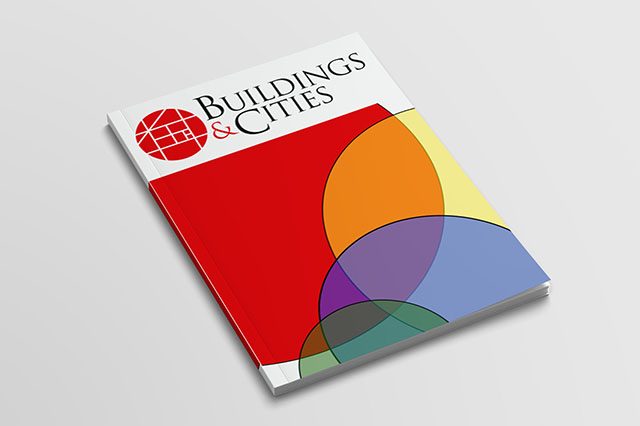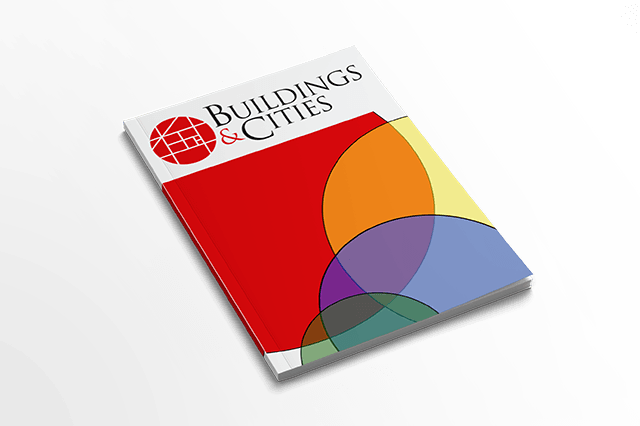
www.buildingsandcities.org/insights/news/welcome.html
Welcome to Buildings and Cities

It is our pleasure to welcome you to the Buildings and Cities journal. We are created by and for the research community that we serve. Our emphasis is on creating, supporting and maintaining a vibrant global and inclusive community of authors and readers.
Our content is diverse and cross-disciplinary. Buildings and Cities considers the interplay and interactions between the different scales of region, city, building stocks, neighbourhood, street or block, and the individual site / building. We also address fragmentation - of disciplinary boundaries and responsibilities, regulation and governance, research and practice.
Understanding how these elements interact is critical for meeting the current challenges we face in policy and practice. We will bring additional content to you - briefing papers, synthesis articles, policy analysis, replication articles, methods articles, commentaries, book reviews.
We're innovative. We will actively encourage engagement with the end users of research - policy makers, practitioners, clients and wider society. We recognise that the dialogue must be two-way to be meaningful. In addition to content on our website, we will partner with organisations to host events to discuss research needs, research findings and the actions that need to arise.
We're launching this journal to respond to the multiple crises and challenges facing the built environment. First and foremost are the challenges in our towns, cities and peri-urban areas to create a built environment that supports human development and ecological systems and reduces resource demand and GHG emissions. Places that are safe, healthy, inclusive, sustainable and adaptable over time. A built environment that mitigates climate change and makes a positive contribution to global and local vitality. The professional responsibilities owed to society are shifting; consequently education, training, skills and organisational practices need to respond.
The editors have a proven reputation for providing a rigorous, high-quality peer-review process for journal articles and curated themed issues. Our previous success at Building Research & Information shows what we can deliver with confidence. We use a double-blind peer review system with a minimum of 3 expert reviewers. Our editors advise and assist authors with the feedback they receive.
We recognise the enormous contribution that authors, reviewers and editors contribute to this journal - so we don't exploit authors' and reviewers' work by extracting a profit. Any surplus will go into the journal or back into the research community as small grants or financial assistance for publishing. We're independent from large publishers who impose strictures on their journals and editors. As a not-for-profit organisation, we are not motivated to publish more and more to benefit shareholders (we have no shareholders).
You are invited to participate in this active community and contribute your research and insights. We will encourage a two-way dialogue and exchange with practitioners, clients, policy makers and the public.

Richard Lorch,
Editor in Chief
Latest Peer-Reviewed Journal Content
Designing for pro-environmental behaviour change: the aspiration–reality gap
J Simpson & J Uttley
Lifetimes of demolished buildings in US and European cities
J Berglund-Brown, I Dobie, J Hewitt, C De Wolf & J Ochsendorf
Expanding the framework of urban living labs using grassroots methods
T Ahmed, I Delsante & L Migliavacca
Youth engagement in urban living labs: tools, methods and pedagogies
N Charalambous, C Panayi, C Mady, T Augustinčić & D Berc
Co-creating urban transformation: a stakeholder analysis for Germany’s heat transition
P Heger, C Bieber, M Hendawy & A Shooshtari
Placemaking living lab: creating resilient social and spatial infrastructures
M Dodd, N Madabhushi & R Lees
Church pipe organs: historical tuning records as indoor environmental evidence
B Bingley, A Knight & Y Xing
A framework for 1.5°C-aligned GHG budgets in architecture
G Betti, I Spaar, D Bachmann, A Jerosch-Herold, E Kühner, R Yang, K Avhad & S Sinning
Net zero retrofit of the building stock [editorial]
D Godoy-Shimizu & P Steadman
Co-learning in living labs: nurturing civic agency and resilience
A Belfield
The importance of multi-roles and code-switching in living labs
H Noller & A Tarik
Researchers’ shifting roles in living labs for knowledge co-production
C-C Dobre & G Faldi
Increasing civic resilience in urban living labs: city authorities’ roles
E Alatalo, M Laine & M Kyrönviita
Co-curation as civic practice in community engagement
Z Li, M Sunikka-Blank, R Purohit & F Samuel
Preserving buildings: emission reductions from circular economy strategies in Austria
N Alaux, V Kulmer, J Vogel & A Passer
Urban living labs: relationality between institutions and local circularity
P Palo, M Adelfio, J Lundin & E Brandão
Living labs: epistemic modelling, temporariness and land value
J Clossick, T Khonsari & U Steven
Co-creating interventions to prevent mosquito-borne disease transmission in hospitals
O Sloan Wood, E Lupenza, D M Agnello, J B Knudsen, M Msellem, K L Schiøler & F Saleh
Circularity at the neighbourhood scale: co-creative living lab lessons
J Honsa, A Versele, T Van de Kerckhove & C Piccardo
Positive energy districts and energy communities: how living labs create value
E Malakhatka, O Shafqat, A Sandoff & L Thuvander
Built environment governance and professionalism: the end of laissez-faire (again)
S Foxell
Co-creating justice in housing energy transitions through energy living labs
D Ricci, C Leiwakabessy, S van Wieringen, P de Koning & T Konstantinou
HVAC characterisation of existing Canadian buildings for decarbonisation retrofit identification
J Adebisi & J J McArthur
Simulation and the building performance gap [editorial]
M Donn
Developing criteria for effective building-sector commitments in nationally determined contributions
P Graham, K McFarlane & M Taheri
Join Our Community

The most important part of any journal is our people – readers, authors, reviewers, editorial board members and editors. You are cordially invited to join our community by joining our mailing list. We send out occasional emails about the journal – calls for papers, special issues, events and more.
We will not share your email with third parties. Read more


Latest Commentaries
COP30 Report
Matti Kuittinen (Aalto University) reflects on his experience of attending the 2025 UN Conference of the Parties in Belém, Brazil. The roadmaps and commitments failed to deliver the objectives of the 2025 Paris Agreement. However, 2 countries - Japan and Senegal - announced they are creating roadmaps to decarbonise their buildings. An international group of government ministers put housing on the agenda - specifying the need for reduced carbon and energy use along with affordability, quality and climate resilience.
Building-Related Research: New Context, New Challenges
Raymond J. Cole (University of British Columbia) reflects on the key challenges raised in the 34 commissioned essays for Buildings & Cities 5th anniversary. Not only are key research issues identified, but the consequences of changing contexts for conducting research and tailoring its influence on society are highlighted as key areas of action.